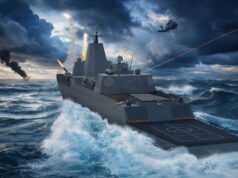Sailors aboard the aircraft carrier USS Theodore Roosevelt are giving the massive aircraft carrier a deep clean to sanitise the vessel after a Coronavirus outbreak.
“Following routine naval operations in the South China Sea the Sailors of USS Theodore Roosevelt are face-to-face with a new, silent and invisible enemy, the coronavirus disease 2019 (COVID-19). They are fighting back, and the crew is now winning. In the beginning, fighting the virus resembled a damage control scenario, similar to fighting a fire or flood. Capt. Dan Keeler, executive officer aboard Theodore Roosevelt, established a command center akin to damage control central in a ship casualty, in the executive officer’s conference room”, say the U.S. Navy in a news release.
Cmdr. Jennifer Huck, Theodore Roosevelt’s combat directions center officer, was appointed as the initial officer in charge and was quoted as saying.
“We have two tasks, taking care of Sailors and cleaning the ship,” said Huck.
“We are focused on taking care of the Sailor’s health and ensuring the ship’s crew is following all centers for disease control and prevention guidelines to include personal protective equipment (PPE). Our medical department is doing great work testing, isolating and treating Sailors. We are going to thoroughly clean the ship. We have already started and are about finished.”
The cleaning task force is led by Cmdr. Chad Hollinger, Theodore Roosevelt’s weapon’s officer, who the crew has taken to calling “Mr. Clean”.
“The team’s mission is to fully sanitise the ship,” said Hollinger.
“To complete the mission we are going to clean this ship from top-to-bottom and forward-to-aft to create a clean zone for everyone coming back to the ship, so we can get back to business. We hit the virus with chemicals we know will kill it, and after that space is clean, we seal it off. We have cleaned over 2,000 spaces so far and have cleaned over 80 percent of the ship. I couldn’t be more proud to take on the task of leading this team and I couldn’t have asked for a better team to get this done. It hasn’t been easy; it’s hard work, but we are fighting through it. There is a light at the end of the tunnel, and we are going to get there.”












I think Captain Crozier had to do what he had to do, in order to protect his crew… Hopefully natural justice prevails and he gets re-instated…
Here here, the man put his crew first and stood up for them. He is a credit to the US Navy and deserves to be re-instated.
Give Capt Crozier a British passport and an RN QE carrier.
Agreed, pretty disgusting treatment from the US government from a man who as you say did what he had to.
If they left the ship alone for a couple of days wouldn’t any remaining covid-19 virus die? Only saying….
Well if your prepared to sacrifice a few additional crew members unnecessarily then you could do that…. the ship is operating in peacetime conditions so why would you let the virus kill them?…. that’s pretty heartless, and that’s the reason the captain went outside the chain of command.
In times of tension/war, I’m sure the ship would still be able to operate with an infected crew, just not at 100% though..
You are right that the virus does not live long on surfaces. UV is also a good virus killer if airborne in sunlight.
The Covid virus spreads mainly by human contact. So just to reassure the crew that the virus has gone, maybe?
Only saying…but wrong.
Virus lives up to seven days on exposed metal and plastic surfaces, which I guess are the primary surfaces in a carrier living quarters.
Maybe that’s why the US Navy decided to deep clean – you know, because they had the facts.
And maybe you should check your fire and pipe down with the scuttle-butt. Only saying…
A chart in Business Insider indicates that the Corona virus only lasts on steel surfaces 2 to 3 days, and plastic 3 days!
Business Insider say so, eh? And they explained that to you in a diagram no less. What a weighty scientific tome you’ve quoted.
My facts come from The Lancet, which published the following research article (see paragraph two, line 19 – STEEL AND PLASTIC 7 DAYS).
https://www.thelancet.com/journals/lanmic/article/PIIS2666-5247(20)30003-3/fulltext
Yeah, the Business insider said so and they got their information from this study below. The team was led by Vincent Munster at the US National Institute of Allergy and Infectious Diseases in Montana
https://www.nejm.org/doi/full/10.1056/NEJMc2004973
the relevant bit I’ll highlight.
The stability kinetics of SARS-CoV-1 were similar (from 103.4 to 100.7 TCID50 per milliliter after 72 hours on plastic and from 103.6 to 100.6 TCID50 per milliliter after 48 hours on stainless steel).
Fact’s are and as The WHO has said this there is currently no peer-reviewed data available on the stability of 2019-nCoV on surfaces. Data from laboratory studies on SARS-CoV and MERS-CoV have shown that stability in the environment depends on several factors including relative temperature, humidity, and surface type.
The newscientist wrote a good article where it mentions the 2 lab tests where it said ‘But other research suggests that SARS and MERS, which are similar coronaviruses, can persist on metal, glass and plastic surfaces for up to nine days. And on Monday, the US Centers for Disease Control published a report suggesting traces of the new coronavirus could be present on surfaces for even longer – RNA from the virus was detected on surfaces in the cabins of people who had vacated the Diamond Princess cruise ship 17 days earlier, including those passengers who hadn’t shown symptoms
https://www.newscientist.com/article/2238494-how-long-does-coronavirus-stay-on-surfaces-and-can-they-infect-you/
So it just shows that those in the labs ding the different tests are not that close at all.
Saying all this, long story short you’re correct it’s longer than a couple of days.